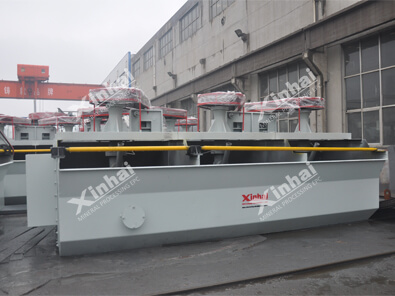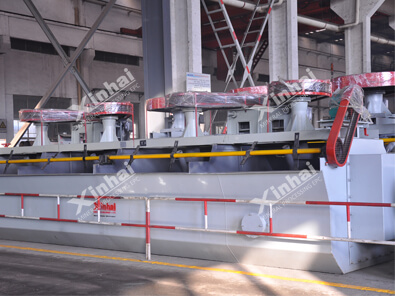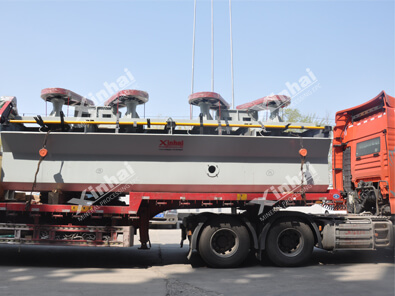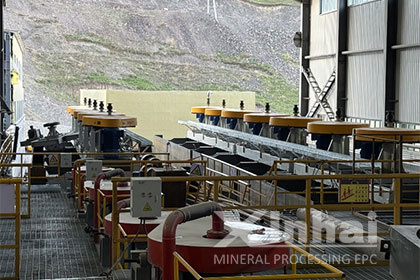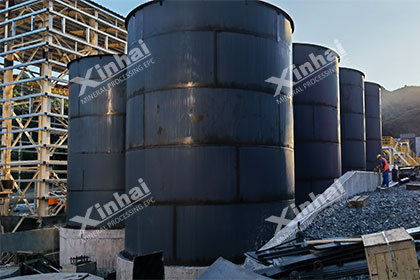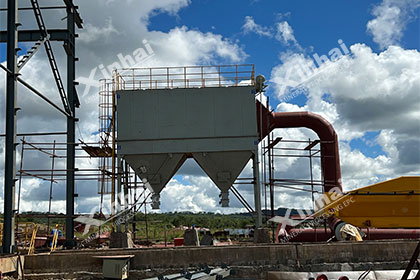Flotation Techniques in Graphite Processing: Separating Graphite from Impurities
 Laura
Laura
 Oct 25, 2023
Oct 25, 2023
 2671
2671
If you want to know more details about equipment, solutions, etc, please click the button below for free consultation, or leave your requirements!
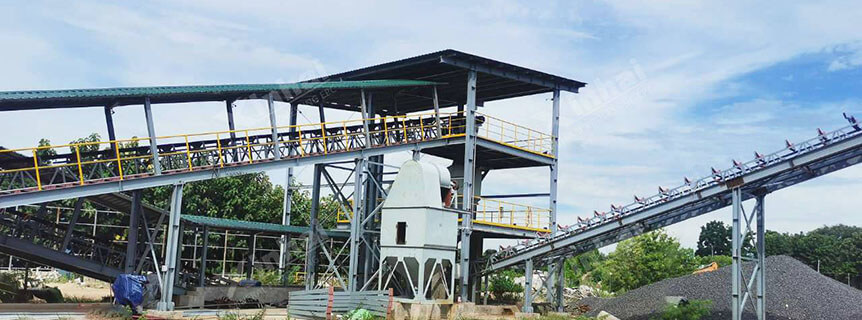
( Belt conveyor equipment is working in a mineral dressing plant )
Graphite, a form of carbon, is an essential mineral used in numerous industries due to its unique properties such as thermal conductivity, lubricity, and electrical conductivity. However, natural graphite often contains impurities that need to be removed to obtain high-purity graphite suitable for industrial applications. Flotation techniques have proven to be highly effective in separating graphite from impurities. In this comprehensive guide, we will explore the various flotation techniques used in graphite processing and how they contribute to the purification process.
01Understanding Flotation Techniques
Back1. What is Flotation?
Flotation is a mineral processing technique that utilizes the differences in surface properties of minerals to separate them from each other. It involves the selective attachment of air bubbles to the valuable mineral particles, which then rise to the surface of the flotation cell as froth, leaving behind the unwanted gangue or impurities.
2. Importance of Flotation in Graphite Processing
Flotation plays a crucial role in graphite processing as it enables the separation of graphite from various impurities. Graphite ores often contain minerals such as quartz, mica, feldspar, and other carbonaceous materials, which need to be separated to obtain high-purity graphite. Flotation techniques offer an effective solution by selectively attaching air bubbles to the hydrophobic graphite particles, allowing their separation from the hydrophilic impurities.
02Flotation Techniques in Graphite Processing
Back1. Conventional Flotation
Conventional flotation is a widely used technique in graphite processing. It involves the addition of specific chemical reagents to the graphite ore slurry, which selectively render the graphite particles hydrophobic. Air bubbles are then introduced into the slurry, and the hydrophobic graphite particles attach to these bubbles, rising to the surface and forming a froth layer. The froth, containing the graphite concentrate, is subsequently mechanically skimmed off.
2. Column Flotation
Column flotation is an advanced variation of conventional flotation that offers improved performance in graphite processing. In this method, a tall column filled with finely dispersed air bubbles is used instead of a conventional flotation cell. The increased concentration of air bubbles in the column enhances the flotation kinetics and the recovery of graphite particles. Column flotation is particularly beneficial for capturing fine graphite particles that might otherwise be lost in conventional flotation.
3. Reverse Flotation
Reverse flotation is employed when the impurities in the graphite ore are more hydrophobic than graphite itself. In this technique, the flotation conditions and chemical reagents are adjusted to selectively float the impurities, while the graphite particles remain in the slurry. By carefully manipulating the pH and using appropriate collectors and frothers, impurities such as silicates and sulfides can be separated, resulting in a purified graphite concentrate.
03Factors Affecting Graphite Flotation
BackSeveral factors influence the efficiency and effectiveness of graphite flotation.
1. Particle Size and Liberation
The particle size and liberation characteristics of graphite are critical factors inachieving successful flotation. Finely ground graphite particles tend to exhibit better flotation performance as they offer a larger surface area for bubble attachment. Additionally, liberation of graphite from the gangue minerals is essential to ensure maximum recovery.
2. Graphite Ore Grade
The grade of the graphite ore, which refers to the carbon content, significantly influences the flotation process. Higher-grade ores generally yield higher graphite recoveries and purities. However, lower-grade ores can still be economically processed by optimizing the flotation conditions and using appropriate reagents.
3. Impurity Composition
The type and composition of impurities present in the graphite ore can impact the flotation process. Different impurities may require specific chemical reagents and flotation conditions for effective separation. Understanding the impurity composition is crucial for designing an optimized flotation circuit.
4. pH and Chemical Reagents
The pH level of the flotation pulp and the selection of chemical reagents play a vital role in graphite flotation. The pH affects the charge properties of the minerals and the efficiency of the collectors and frothers. Optimal pH conditions should be determined to achieve the desired flotation performance.
04Chemical Reagents Used in Graphite Flotation
BackVarious chemical reagents are employed in graphite flotation to achieve the desired separation.
1. Collectors
Collectors are surface-active agents that selectively adsorb onto the graphite particles, rendering them hydrophobic. Commonly used collectors in graphite flotation include hydrocarbons, fatty acids, and their derivatives. The choice of collector depends on the ore characteristics and the impurity composition.
2. Frothers
Frothers are added to the flotation pulp to stabilize the froth and improve the mobility of the air bubbles. They reduce the bubble size and enhance the froth stability, thereby aiding in the efficient removal of the froth containing the graphite concentrate. Common frothers used in graphite flotation include alcohols, glycols, and polyglycols.
3. pH Modifiers
pH modifiers are used to adjust the pH level of the flotation pulp to the optimal range for graphite flotation. Alkaline or acidic reagents can be added to manipulate the pH depending on the desired separation requirements. pH modifiers also influence the charge properties of the minerals, affecting their interaction with collectors and frothers.
05Flotation Process Optimization
BackOptimizing the flotation process is crucial to achieve high-purity graphite concentrates with maximum recovery.
1. Ore Characterization and Testing
Thorough ore characterization and laboratory testing are essential to understand the ore's mineralogy, liberation characteristics, and response to flotation. This information helps in selecting the appropriate flotation techniques, reagents, and operating conditions for the specific ore.
2. Flotation Circuit Design
Flotation circuit design involves determining the optimal arrangement and configuration of flotation cells, reagent dosages, and operating parameters. Factors such as residence time, pulp density, and froth depth need to be carefully considered to maximize graphite recovery and minimize impurity content.
3. Process Control and Monitoring
Implementing effective process control and monitoring systems ensures consistent and efficient flotation performance. Regular analysis of key parameters such as pH, reagent dosages, froth characteristics, and concentrate grade allows for timely adjustments and optimization of the flotation process.
06Environmental Considerations in Graphite Flotation
BackMinimizing the environmental impact of graphite flotation operations is of paramount importance.
1. Water Usage and Management
Efficient water usage and management strategies should be implemented to minimize water consumption and ensure responsible water stewardship. Techniques such as recycling, water treatment, and optimizing process water circuits can significantly reduce the overall water footprint of graphite flotation plants.
2. Reagent Selection and Handling
The selection and handling of chemical reagents should consider their environmental impact and potential risks. Environmentally friendly and biodegradable reagents should be preferred whenever possible. Proper storage, handling, and disposal of reagents are essential to prevent environmental contamination.
3. Tailings Management
Appropriate tailings management practices are crucial to prevent the release of contaminants into the environment. Tailings storage facilities should be designed and operated in compliance with industry best practices to ensure long-term stability and minimize the risk of water and soil pollution.
07Future Trends in Graphite Flotation
BackGraphite flotation is a continually evolving field, driven by advancements in technology, sustainability concerns, and ongoing research and development efforts. Several future trends are expected to shape the landscape of graphite flotation.
1. Advancements in Flotation Technology
The development of new and improved flotation technologies is expected to enhance the efficiency and effectiveness of graphite flotation. Researchers and engineers are exploring novel flotation equipment designs, such as high-capacity flotation cells and advanced column flotation systems, to optimize graphite recovery and concentrate purity. These advancements aim to overcome challenges associated with fine particle flotation, improve froth stability, and increase the overall flotation performance.
Moreover, the integration of automation, artificial intelligence, and machine learning in flotation systems holds great promise. Real-time monitoring and control systems can optimize process conditions, reagent dosages, and flotation parameters based on data analysis, leading to improved flotation outcomes and reduced operational costs.
2. Sustainable Flotation Practices
In recent years, there has been a growing focus on sustainable practices in the mining industry, including graphite flotation operations. The adoption of sustainable flotation practices aims to minimize the environmental impact, reduce energy consumption, and optimize resource utilization.
One area of interest is the development of eco-friendly reagents for graphite flotation. Researchers are exploring alternative collectors and frothers derived from renewable sources or utilizing bio-based materials. These sustainable reagents not only reduce the environmental footprint but also offer comparable or improved performance in terms of graphite recovery and concentrate quality.
Additionally, efforts are being made to optimize water management and reduce water consumption in flotation plants. Water recycling, efficient tailings dewatering, and advanced water treatment technologies are being implemented to minimize freshwater usage and ensure responsible water stewardship.
3. Research and Development
Research and development (R&D) initiatives play a crucial role in driving innovation and advancing the field of graphite flotation. R&D efforts are focused on gaining a deeper understanding of the fundamental aspects of graphite flotation, including ore mineralogy, particle interactions, and the role of various flotation parameters. This knowledge is vital for developing new strategies, optimizing existing processes, and addressing specific challenges associated with different graphite deposits.
Furthermore, ongoing research aims to explore alternative beneficiation techniques beyond conventional flotation. Techniques such as gravity separation, electrostatic separation, and hydrometallurgical methods are being investigated to complement or replace flotation in certain scenarios. These alternative approaches may offer additional opportunities for improving graphite recovery and concentrate quality, especially for complex or low-grade ores.
Collaboration between researchers, industry stakeholders, and academic institutions is crucial to facilitate knowledge sharing, technology transfer, and the development of innovative solutions in graphite flotation.
08Conclusion
BackFlotation techniques have revolutionized the graphite processing industry, enabling the efficient separation of graphite from impurities. Conventional flotation, column flotation, and reverse flotation are valuable methods employed to achieve high-purity graphite concentrates.
Various factors, including particle size, liberation characteristics, ore grade, impurity composition, pH, and chemical reagents, influence the flotation process. Optimization of these factors, along with thorough ore characterization, flotation circuit design, and process control, maximizes graphite recovery and concentrate purity.
As the graphite industry progresses, future trends in flotation will focus on advancements in flotation technology to improve performance, sustainable practices to minimize environmental impact, and ongoing research and development to uncover innovative solutions. By embracing these trends, the graphite processing industry can continue to meet the growing demand for high-quality graphite while minimizing its ecological footprint.
Tags: Don't let impurities hinder the quality of your graphite products. Reach out to us now to explore innovative flotation techniques that can enhance the purity of your graphite processing!
 +86 183 3575 8886
+86 183 3575 8886 pinklaurabao@gmail.com
pinklaurabao@gmail.com




 Message
Message Chat Now
Chat Now


